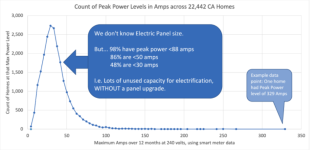@JohnHess
Which large PoCo ?
There's a ton of data on this exact issue taken from thousands of homes. And in fact, that data was presented to the NEC committee at the technical meeting stage, resulting in new calc language in the 2026 code cycle.
TL;DR panels have been oversized by those calculations for a long time.
Most of the new formulas made it through the whole cycle, except for one, and that's the subject of an appeal August 18th 2025.
Send a private message I can get you a full summary.
---
For maximum demand it depends on the PoCo. Identify yours for more help. Generally, you can find it on a bill as a "demand charge" or "peak charge". In some cases, you can download 1- or 15-minute data and find the peaks yourself. However, in other cases you only get 1 hour data which is kind of chancy for making load assumptions.
There are now a TON of ways to "peak shave" these days. Or, to have a new device dance about and use power only when the panel has capacity.
------
Eaton's appeal on load related issues reads in part
NFPA Standards Council
1 Batterymarch Park
Quincy, MA 02169
RE: Appeal regarding CAM 70-87 18 July 2025
Dear Ms. Bellis,
I am writing to formally appeal the outcome of certified amending motion 70–87. This is a unique case of where the process created a situation that negatively impacts all parties involved and arguably negatively impacts electrical safety as well. ....
The issue stems from a correlation problem created by the recent process involving Certified Amending Motion 70–87. As per the motion made at the annual meeting, Public Comment 1854 was accepted, which proposed increasing the VA/ft2 for calculating the number of branch circuits in a dwelling unit from 3 VA/ft2 to 4 VA/ft2. ....
If we are not careful, the calculation for the number of branch circuits for a dwelling unit could shift to a 2 VA/ft2 basis....
This motion passed at the annual meeting, and according to NFPA's regulations, such a motion requires that the committee, in
this case CMP-2, be balloted. However, CMP- 2 did not support the ballot. As per the NFPA standards development procedures, when this occurs, the text must revert to the language of the previous edition, which in this case is the 2023 National Electrical Code (NEC). The
2023 NEC did not contain Section 120.13, and NFPA regulations dictate that if no corresponding text exists in the previous edition, the section must be deleted. Thus, Section 120.13 is being deleted.


